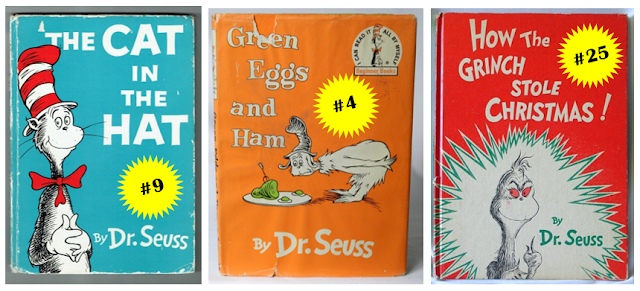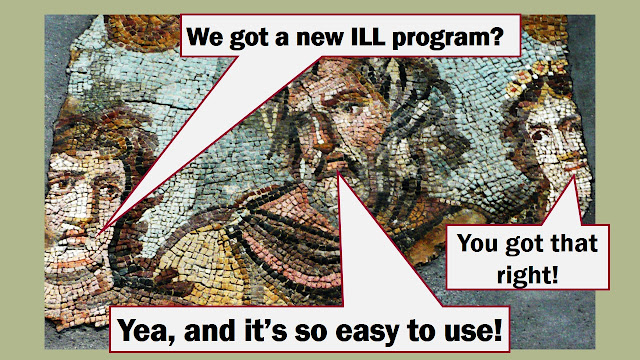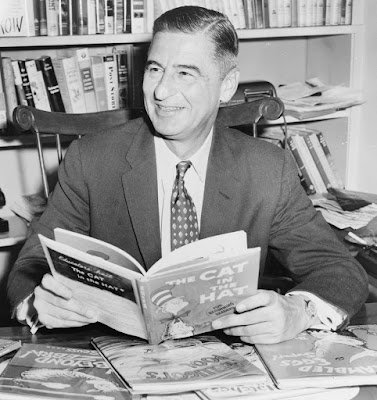Award-winning* author Theodor Seuss Geisel, best known as Dr. Seuss, was born 114 years ago on March 2, 1904, in Springfield, Massachusetts. Best known as a children’s book author,
(with good reason as he published over 60 during his life-time), Geisel’s books have been translated into at least twenty languages. Over
200 million copies of his books have sold worldwide.
Geisel got his start creating political cartoons and satire
(he was voted class artist and class wit in his senior year
of high school), and was widely published in over one thousand newspapers and
sixty periodicals. Geisel was also an
advertising man.
Despite this, or more likely because of this, Depression-era
publishers were reluctant to publish a children’s book by Geisel. Thankfully, Geisel persevered, and after
multiple rejections, And to Think That I Saw It On Mulberry
Street, was published in 1937, to much acclaim.

It is Geisel’s “I Can Read It All By Myself” Beginner Books
that are the true stars sales-wise.
Responding to a challenge from his publisher to write a story using a
prescribed first grade word list, Geisel crafted The Cat in the Hat using 225 of the words. Published in 1957, the book was an instant
best seller.
In 2001 Publishers
Weekly listed The Cat in the Hat as the ninth all-time best-selling hardcover children’s book. Green
Eggs and Ham, Geisel’s response to his publisher’s bet that he couldn’t write
an entire book using only 50 different words, fared even better—according to the
same list, this is the fourth all-time best-selling hardcover children’s
book. In comparison, How the Grinch Stole Christmas (published in 1957), while certainly a top-seller, is “only” twenty-fifth.

Theodor Seuss Geisel passed away on September 24, 1991 in La Jolla, California, but his legacy lives on. Geisel
changed the world of children’s literature—and books to teach children how to
read— forever.
Make yourself comfortable, and grab a book or two by—or
about— Dr. Seuss. Happy reading!
*Theodor Seuss Geisel received
many awards. Here is a partial list: Pulitzer, Lifetime of
Contribution to Children’s Literature (1984) ; Academy award & Oscar, Best Cartoon (Gerald McBoing-Boing, 1951) ; Emmy, Best Children’s Special (Halloween is
Grinch Night, 1977, and The Grinch Grinches
the Cat, 1982) ; Peabody (animated
specials How the Grinch Stole Christmas! and Horton Hears a Who!,
1971).
Information from:
Krull, Kathleen. The boy on Fairfield Street : How Ted Geisel Grew Up to Become Dr.
Seuss. New York: Random House, 2004.
Pease, Donald E.. Theodor Seuss Geisel. New York: Oxford
University Press, 2010.
Images from:
(Children in Seuss hats): “Get Ready to Read Across America!” National Education Association. www.nea.org/grants/886.htm.
Accessed 27 Feb. 2018.
(Political cartoon, first published July 8, 1941): Minear, Richard H. Dr. Seuss Goes to War : the World War II Editorial Cartoons of Theodore Seuss Geisel. New York: The New Press, 1999. Page 38. Also, @DaveKeating. “America
First was an isolationist movement in the late 1930s with strong links to Nazi
Germany. This is a 1941 political cartoon by Dr Seuss." Twitter,
23 Jan 2017, 9:00 p.m., twitter.com/davekeating/status/823757315438362625.
(Flit ad): Voort, Garry Vander. “Classic
Pesticide Ad with Illustration by Dr. Seuss.”
Retroist, Sept. 22, 2009. http://www.retroist.com/2009/09/22/classic-pesticide-ad-with-illustration-by-dr-seuss/
(Black and white portrait): Ravenna, Al. World Telegram & Sun, 1957. Wikipedia Commons. commons.wikimedia.org/wiki/File:Ted_Geisel_NYWTS_2_crop.jpg












